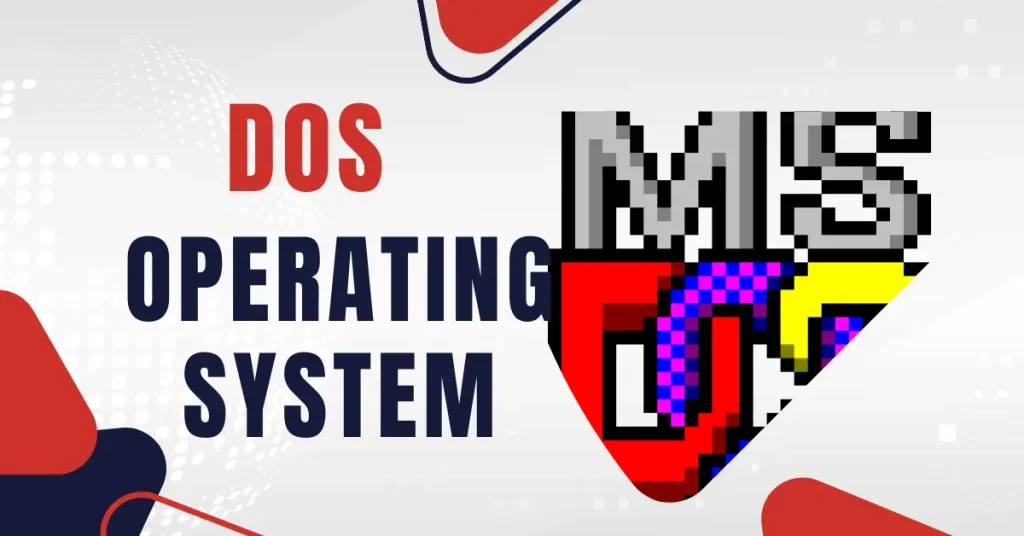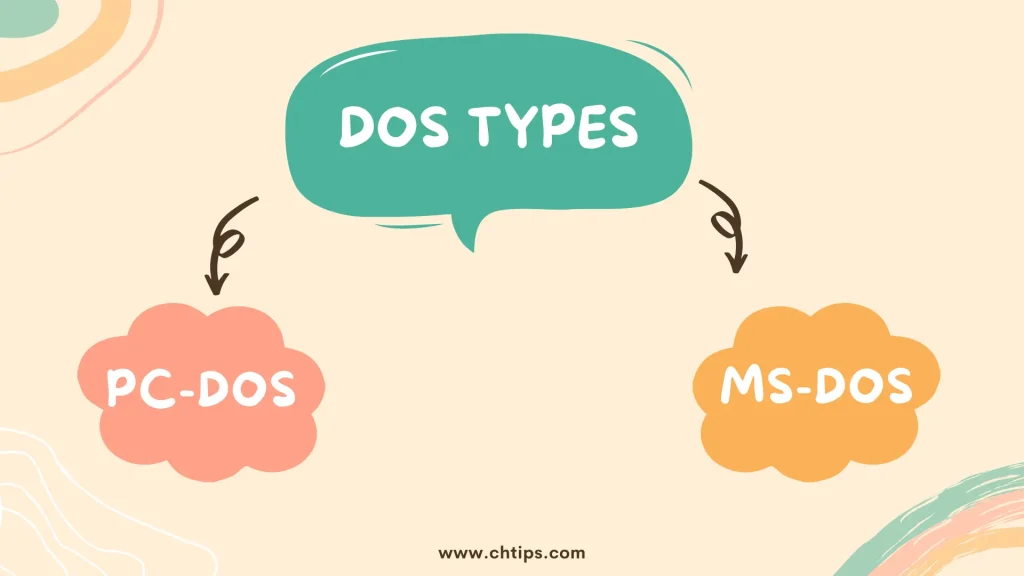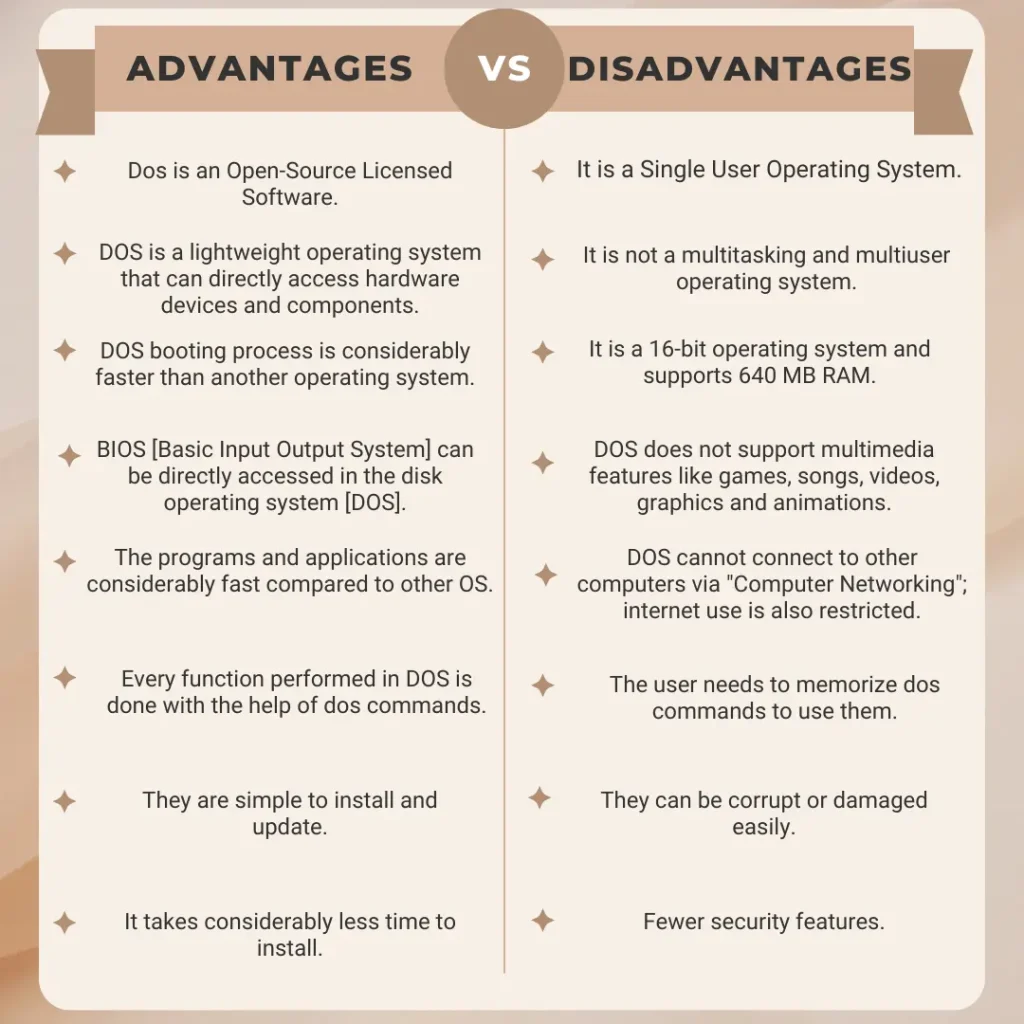Dos is one of the first operating systems designed and developed by software giant Microsoft.
The amazing features and characteristics of the dos operating system made them very popular among users, and soon it ruled the IT industry.
DOS entirely changed the market as it was user-friendly to use and handle.
Still, there are some significant Advantages and Disadvantages of Dos Disk Operating System | Benefits and Drawbacks of DOS that are discussed further in the article.
Let's get started.
What is MSDOS [Microsoft Disk Operating System]
MS-DOS stands for Microsoft Disk Operating System.
DOS is a single-user and single-tasking operating system that is operated with the help of hard disk drives.
It is a text-based, or character user interface operating system that does not support graphics and animations.

Dos use and utilize the command line for executing commands and instructions given to the computer system to receive desired output.
Dos acts as an interface between the user and the computer system.
Dos is a light weighted operating system that also requires less memory for processing and execution.
Therefore, the time required for the booting process is considerably lesser than other windows operating systems.
Dos manages disk and disk files. It also acts as a bridge between computer hardware and software applications.
It is a NON-GUI operating system that works with CUI [Character User Interface].
Different Types of DOS [Disk Operating System]
There are two types of DOS they are as follows.
- PC-DOS
- MS-DOS

10 Advantages and Disadvantages of Dos | Benefits and Drawbacks of DOS in Tabular Form
| # | Advantages of DOS | Disadvantages of DOS |
| 1 | Dos is an Open-Source Licensed Software. | It is a Single User Operating System. |
| 2 | DOS is a lightweight operating system that can directly access hardware devices and components. | It is not a multitasking and multiuser operating system. |
| 3 | DOS booting process is considerably faster than another operating system. | It is a 16-bit operating system and supports 640 MB RAM. |
| 4 | BIOS [Basic Input Output System] can be directly accessed in the disk operating system [DOS]. | DOS does not support multimedia features like games, songs, videos, graphics, and animations. |
| 5 | The programs and applications are considerably fast compared to other OS. | DOS cannot connect to other computers via “Computer Networking”; internet use is also restricted. |
| 6 | Every function performed in DOS is done with the help of dos commands. | The user needs to memorize dos commands to use them. |
| 7 | They are simple to install and update. | They can be corrupt or damaged easily. |
| 8 | It takes considerably less time to install. | Fewer security features. |
| 9 | Dos enhanced performance and speed of computer system. | It can run and execute a single program at a time. |
| 10 | DOS commands are not case-sensitive. | Tasks and operating can not be performed on spelling errors. |
| 11 | DOS is a command-line operating system. | The dos command can sometimes be difficult to memorize and learn and execute. |
| 12 | Dos consume less power and memory. | Dos is not used in this graphical world; therefore, it has been easily replaced by a more advanced windows operating system. |
Advantages and Disadvantages of Dos | Benefits and Limitations of Dos

Brief History of DOS [Disk Operating System]
Microsoft Corporation designed and developed DOS for the Disk Operating system and released it on 12th August 1981.
It was an extension of CP/M that allowed computers with less memory capacity and storage than a floppy disk drive to run programs stored on magnetic disks or tapes.
Since then, various versions of DOS and windows have been rolled out in the market with a commercial license and open source license.
MS-DOS 1.0 (1977)
This was the original version of Microsoft’s Disk Operating System (DOS).
It allowed users to run programs from their hard drives and connect to other computers using a modem or serial connectors.
It also included commands such as Copy, Xcopy, Edit, and Rename so that files could be moved around easily on your hard drive without knowing much about it!
MS-DOS 2.0 (1980)
This updated version of MS-DOS added support for high-density floppy disks while still keeping compatibility with old software written for 1. x versions.
However, some features, such as memory management, were removed so that programs could take advantage of the extra space available on newer disks.
The latest versions of DOS improved upon this original version by adding support for hard drives and expanding file management features such as copy, paste and delete operations and context-sensitive help files within applications.
This led to more advanced features like multitasking support being added to newer versions such as Windows 3.1.
It still uses DOS underneath its shell layer. Still, it offered improved performance compared to previous releases since it no longer had any external dependencies apart from end-user input devices such as mice.
5 Important Uses of DOS
- The disk operating system (DOS) is the most basic operating system used on personal computers.
- DOS comes preinstalled in most operating systems like windows and MAC.
- The Disk operating system is an important tool for computer users. It enables you to run programs and read files from your hard disk drives.
- The disk operating system controls how files and directories [folders] are stored on your computer’s hard drive and how they are retrieved when needed.
- The simple commands make navigating through files, folders, and directories easy without using a mouse.
Different Versions of DOS in Tabular Form
| DOS Version | Year | Developer |
| 86-DOS | 1980 | Tim Paterson |
| PC-DOS 1.0 | 1981 | Microsoft |
| PC-DOS 1.1 | 1982 | Microsoft |
| PC-DOS 2.0 | 1983 | Microsoft |
| PC-DOS 3.0 | 1984 | Microsoft |
| IBM -DOS 4.0 | 1988 | IBM |
| DR DOS 5.0 | 1990 | Digital Research |
| DR DOS 6.0 | 1991 | Digital Research |
| MS-DOS 6.22 | 1994 | Microsoft |
10 Dos Commands
There are two distinct types of dos commands.
- Internal Dos Commands.
- External Dos Commands.
Internal Dos Commands
Internal Dos Commands are basic dos commands that use the command.com [Command Processor] file for execution.
Some Examples are
- Cls
- Date
- Time
- Copy con
- Type
- Rename
- copy
- Dir
- MD
- CD
- RD
- Volume
- Ver
- Echo
External Dos Commands
The external dos commands are executed from external sources like a floppy disk and hard disk.
- Format
- Copy
- SYS
- Chkdsk
- Delete
- Doskey
- Tree
- Edit
- Mode
- label
- Attrib
- Backup
- help
Differences Between Dos and Windows Comparison Table
| # | Dos | Windows |
| 1 | Dos is a Single User and Single Tasking Operating System | Windows is a Multitasking and Multi-User OS |
| 2 | It is faster than windows. | The Booting Process is slower compared to DOS as it requires huge memory for executions. |
| 3 | It is a Non-GUI operating system | It is based on GUI. |
| 4 | It does not support networking. | Supports Networking. |
| 5 | Open Source Licensed | Paid License. |
People are Also Reading
- What is Disk Operating System [DOS]
- Features of MSDOS Operating System
- What are Basic Dos Commands? [Internal And External]
- How To Make A Batch File Using Dos Commands
- What is a Wild Card? and How to Use Them
- Basic Computer Fundamentals
Frequently Asked Questions on Dos Advantages and Disadvantages
Who Invented DOS?
American computer programmer Timothy Paterson initially designed and developed DOS.
Was DOS the first Operating system developed by Microsoft?
Microsoft designed and developed DOS in 1981 and licensed it to over 70 companies.
What is the current version of DOS?
The last retail version of MS-DOS was MS-DOS 6.22. Microsoft has stopped support of dos since 2006.
What are the parts of DOS?
There are mainly three parts of dos they are.
I/O handler, command processor, and auxiliary utility programs.
Is DOS open or closed source?
Dos is open-source and free software.
Which is better, DOS or Windows?
Windows are far more user-friendly and easy to use compared to DOS; therefore, windows are preferred over dos.
Get In Touch
I have also written and compiled some articles on computers and telecommunications, and please go through them.
I hope you will like reading it.
All the questions and queries related to the Advantages and Disadvantages of DOS | Drawbacks and Benefits of DOS are answered here.
If you have any questions about the Pros and Cons of DOS.
Don’t hesitate to contact me, and if you feel to add, remove or update anything from the article, please let me know in the comment section or via email.
I will be more than happy to update the article. I am always ready to correct myself.
Please share this article with your friends and colleagues; this motivates me to write more related topics.
!!! Thank You !!!